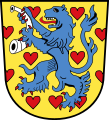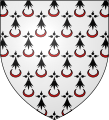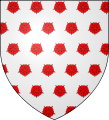sown and sprinkled (heraldry)
The terms sown and sprinkled in the technical language of heraldry , the blazon , denote a regular pattern with many small identical figures.
To the terms covered, sprinkled and sown
In principle, each heraldic figure can form one or more fields , i.e. areas that can be further attributed. If one or more pieces appear on this space, one speaks of occupied . Whenever a defined number of the same figures is required, one is emblazoned . If one only wants to express a general pattern, one speaks sprinkled or sown . One then emblazoned something: blue, seeded or sprinkled with golden lilies .
In principle, the two expressions mean the same thing, but some authors have become more precise.
- sprinkled = small figures evenly distributed throughout the shield without touching the edge
- seeded = the same when the figures are cut at the edges
With the former, the characters can also be seen more independently as secondary characters , with the latter they have more of the character of a pattern than a filling image .
- "Seeded" and "sprinkled"
Gold, studded with red hearts, a blue, red-armored lion
( Gifhorn district )Gold, sprinkled with red hearts, a blue, red-armored lion
( Harburg district )

Historically, a distinction was not always made between occupied (without specifying the number) and seeded / sprinkled : Since the wording of the blazon is valid in heraldry, not the specific representation, it is generally not possible to say exactly whether the cutting on the edge is binding or not.
Often it is the representation following a specific tradition or she derives from the nature of the assignment and the edge lines and their meaning: A line of a crest Association has a character other than a board to the plate, or down an inclined patterning emblem , or the boundary of the heraldic animal itself, if this is occupied (then mainly sown, an eagle, for example, is difficult to sprinkle precisely). Historically, an unspecifically seeded image was often set to a specific number, well-known examples are the Kingdom of France , which in the Middle Ages was set from lily-seeded to 3 lilies (the old lily-seeding can still be found in Old Burgundy ), or the Kingdom of Denmark , today 9 hearts (each leopard accompanied by three).
The heraldic color rule that metal and paint must not touch is particularly strict here. Cases are tolerated in which - not deliberately violating the color rule - colors are combined and subsequently sprinkled for political or family reasons or the combined coat of arms inherits sprinkling as an important characteristic.
variants
In principle, any figure can be sowed or scattered, and is then often heraldically simplified without losing its character. Without further details, a standard form is meant (which can also be designed differently depending on the author), otherwise all required details must be given.
It can be sprinkled / sown in two different forms, on the one hand like a chessboard, i.e. in rows and rows (heraldic bars and stakes ), on the other hand diagonal (heraldically speaking, diagonally ), this follows from the pattern, small squares, for example, are often in the former form, Lilies placed in a second form, or it is left to the designer of the coat of arms.
The pattern is particularly popular in French-English heraldry. There, numerous special terms have developed for what is sprinkled / sown with, in the form of an adjectivation, some of which have also been translated into German:
- semé of cross-crosslets: crusily - sprinkled / sown with crosses / little crosses
- semé of fleurs-de-lis: semé-de-lis - sprinkled / sown with lilies, sprinkled / sown with lilies
- semé of plates: platé - sprinkled / sown with balls / discs ; especially also:
- semé of torteaux: tortelly - sprinkled / sown with red balls / slices
- semé of bezants: bezanté - sprinkled / sown with golden balls / discs , in German also with coins or pennies
- in silver German: with pebbles
- semé of billets: billeté - sprinkled / covered with clapboard / note / cards , also: clapboard / shingled
- lying: sprinkled / sown with stones / bricks
- maclé - sprinkled / sown with window diamonds
- semé of annulets: annulletty - sprinkled / seeded with rings
- semé of sparks: étincellé - sprinkled / sown with sparks
- semé of guttae: gouttée - sprinkled / sown with drops / tears
- very special terms have become established here: gouttée d'or ('gold'); d'eau (silver, 'water'); de larmes (blue, 'tears'); de sang (red, 'blood'); de poix (black, 'bad luck').
This coat of arms ornament is particularly popular in France, where there are multiple patterns, also combined with several figures.
Examples
a green shield head , sprinkled with bees (in natural colors)
( Saint-Étienne-au-Mont FR)Black, studded with crosses
( Menneville FR)Blue, studded with window rhombuses (bar by beam)
(heraldic pattern)Ermine , sown with red lying moons
( Sainte-Gemme-la-Plaine FR)Silver, seeded with roses (in standard color)
(heraldic pattern)Blue, sprinkled with gold stars ( Västerbotten SE)
Blue, with 10 overturned silbs. Grape leaves sprinkled (expressly state the number,
Petersdorf II AT)
Web links
Individual evidence
- ^ No distinction: G. Oswald: Lexikon der Heraldik , Scheibelreiter: Heraldik ; differentiated: Herold Wappenfibel , W. Leonhardt: The great book of Wappenkunst , Hussmann: Deutsche Wappenkunst. Quoted from: Div. Authors: seeded, sprinkled, shingled, accompanied ( page no longer available , search in web archives ) Info: The link was automatically marked as defective. Please check the link according to the instructions and then remove this notice. . Thread in Heraldik im Netz / Heraldik-Forum , heraldik-wappen.de, May 6, 2009, accessed June 10, 2012
- ↑ for example with very old coats of arms, and especially in transfers from the heraldic systems of other countries: French and English only know the expression semé (English also semy ), until the 17th century in France incision was the norm, since then sprinkled strictly in the German sense usual. A liability for cutting or not cutting can in no way be inferred from Blason and / or representation. According to Bernhard Peter French heraldry: Simpler example blazons with explanations : Example 8: de Villers.













